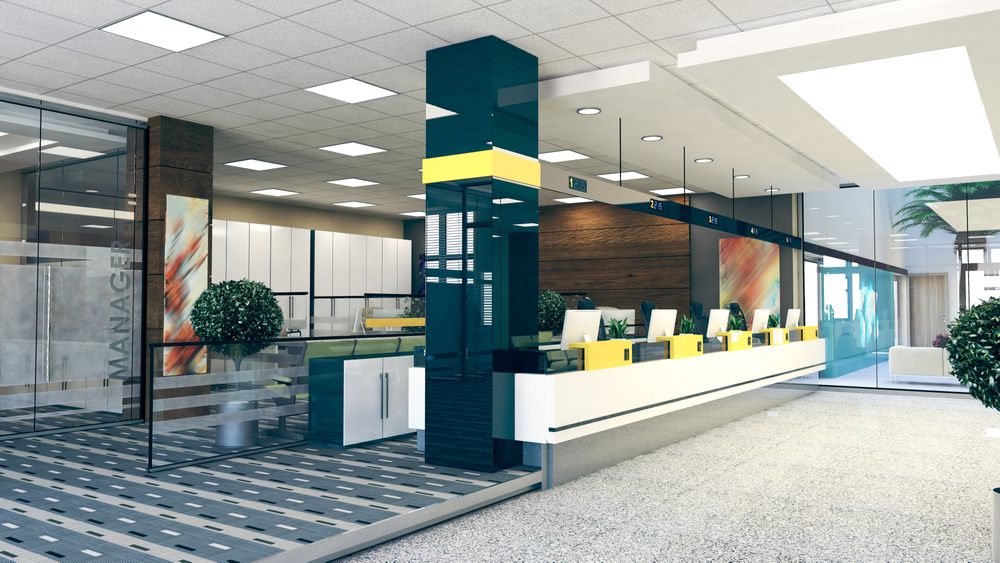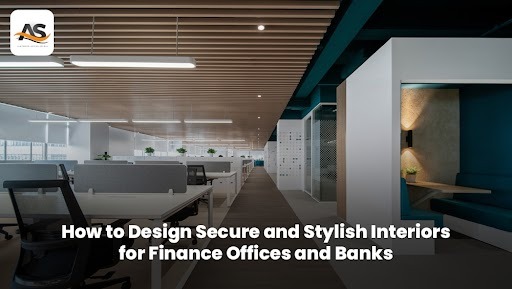Banking and finance offices have evolved far beyond functional spaces with desks and vaults. Today, their interiors represent trust, innovation, and professionalism. A well-designed financial workspace does more than just look appealing — it reflects stability and reliability, which are essential traits in the finance industry.
Modern bank interior design requires balancing three important elements: security, professionalism, and aesthetics. Clients walking into a bank or finance office should immediately feel safe and confident, while employees should experience a comfortable and efficient workspace. The ultimate goal is to create an environment that inspires trust, enhances client comfort, and maintains safety without sacrificing visual appeal.

Understanding the Purpose of Financial Interior Design
The interior of a financial office communicates reliability, stability, and discipline. It affects how clients judge the brand’s credibility.
Design decisions must reflect these values:
Stability: Strong materials, symmetrical layouts, and organized furniture placement.
Confidentiality: Separate private zones for meetings and data handling.
Professionalism: Neutral colors, proper lighting, and clutter-free spaces.
A specialized interior design studio in Pune can plan spaces that maintain the right balance between visual appeal and operational control.
Key Principles of Secure Design in Banks and Finance Offices
Security requirements are strict in banks and financial offices. Design must integrate these features without making the space look technical or heavy.
Key principles include:
Access Control: Divide the space into public, employee, and restricted areas.
Surveillance Integration: Plan CCTV and alarm systems that blend with ceilings and walls.
Sound Control: Use acoustic panels and enclosed rooms for confidential meetings.
Safety Compliance: Include fire exits, alarms, and emergency lighting in the layout.
These steps form the base of every bank interior design project.
Functional Layout and Space Planning
Efficient layouts support both client service and internal operations. The design should guide movement naturally and avoid congestion.
Recommended layout structure:
- Reception and waiting area near the entrance.
- Teller counters with visibility but controlled access.
- Private meeting rooms for discussions.
- Secure back-office zones for administrative work.
The flow must be simple and safe. Clear separation between visitor and employee areas helps maintain confidentiality and order.
Balancing Security with Style
Security features should not dominate the space visually. The design should still appear open, comfortable, and modern.
Design tips:
Use tempered glass for partitions — it adds openness while maintaining privacy.
Apply anti-tamper materials for doors and counters.
Install layered lighting — general, task, and accent — for clarity and aesthetics.
Keep furniture sleek and functional.
The goal is to make the environment look professional but not intimidating.
Material, Lighting, and Color Selection
- Material: Choose durable, fire-resistant, and easy-to-maintain finishes such as laminate wood, stainless steel, or reinforced glass.
- Lighting: Combine natural daylight with energy-efficient LED fixtures. Security lighting must cover all access points without creating glare.
- Color Scheme: Use neutral tones such as grey, beige, and blue. These shades create a calm and reliable atmosphere suited for financial settings.
A professional interior design studio in Pune selects materials and lighting systems that meet both safety standards and visual requirements.
Technology Integration for Modern Financial Spaces
Banks depend on digital systems, and interiors should accommodate them without visual clutter.
Essential integrations:
- Smart access control using biometric or card systems.
- Automated lighting and climate control for energy management.
- Digital displays for customer communication.
- Hidden wiring and secure data cabling routes.
- Technology placement should support convenience, not distraction.
Sustainability and Energy Efficiency
Financial offices are moving toward greener design practices. Sustainable interiors lower operating costs and reflect corporate responsibility.
Sustainable strategies:
- Use LED lighting and motion sensors.
- Choose recycled or locally sourced materials.
- Include indoor plants for air quality.
- Plan natural ventilation and daylight utilization.
An eco-friendly bank interior design approach promotes efficiency while improving indoor comfort.
Role of Professional Designers
Bank and finance interiors involve strict planning, security coordination, and compliance. Hiring experts is essential.
A qualified interior design studio manages:
- Site planning and zoning.
- Coordination with security consultants.
- Material and lighting specification.
- On-site supervision and final installation.
Professional designers ensure that the interiors align with safety regulations and branding goals.
Benefits of Secure and Stylish Financial Interiors
A carefully designed financial office offers multiple advantages:
- Helps clients feel confident in the bank and its services.
- Creates a comfortable and efficient workspace for employees.
- Makes daily operations smoother and safer.
- Reduces long-term upkeep costs and simplifies maintenance.
- Presents a professional and cohesive image for the organization.
FAQ
What is the main role of an interior designer?
The main role of an interior designer is to plan and create functional, safe, and aesthetically pleasing spaces that meet the client’s needs. They combine design, materials, lighting, and layout to enhance both comfort and efficiency.
How to design a bank interior?
To design a bank interior, plan a layout that separates public, staff, and secure zones, ensuring smooth workflow and client comfort. Use durable materials, proper lighting, neutral colors, and discreet security features to balance safety with a professional and welcoming look.
What are the benefits of sustainable design in financial offices?
Sustainable design reduces energy costs, improves indoor comfort, reflects corporate responsibility, and creates a healthier work environment.
How long does it take to design a bank interior?
The timeline depends on the project size and complexity, typically ranging from a few weeks for planning to several months for full execution.
What makes a bank interior secure?
Controlled access zones, discreet CCTV, soundproof meeting rooms, and compliance with safety standards keep the space secure without feeling restrictive.
Conclusion
Financial interiors need to combine security, functionality, and style. A well-designed space builds trust and efficiency while reflecting professionalism. We provide expert interior design services for banks and finance offices. Contact us today to create a secure and elegant workspace.

